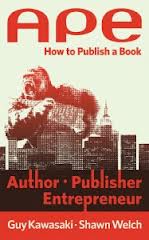Guy Kawasaki Tells Self-Publishers How to Publish a Book
Biff Barnes
I got an email a couple of days ago from Guy Kawasaki, social media guru, founder of alltop.com and former chief evangelist of Apple. It got my attention because, though I admire Guy and have read some of his books, he hadn’t emailed me much, in fact ever, before.
It was the reason for the email that really interested me though. He wanted me to review his book on self-publishing, APE: How to Publish a Book.

Okay. This is a subject I know something about. Nancy and I appear at events and speak to audiences all over the country and talk to people every day by phone and email about self-publishing. At Stories To Tell we advise people about self-publishing, edit and design their books and help them find the best printer who best fits their goals for their books. Want to talk about self-publishing? I can do that.
The question was why did Guy Kawasaki, a best-selling author who had published nine books with traditional publishers, want to talk about self-publishing?
The answer was simple. In 2011 Guy Kawasaki wrote the best-selling book Enchantment. A large technology company wanted to buy five hundred copies of the ebook version, but the book’s publisher, Penguin, was not able to fulfill the order. So Kawasaki decided to become a self-publishing author with his next book, What the Plus? about Google+.
 Guy Kawasaki
Guy Kawasaki
In the process of doing that he learned that for a newbie “…self-publishing is a mystifying, frustrating, and inefficient task.” So he partnered with app developer Shawn Welch who could fill in some technical expertise. Together the two acquired a lot of knowledge of how to navigate this new publishing universe and wrote about it in APE: How to Publish a Book, which they also self-published.
Kawasaki’s goal for the book is simple. “I want to create the Chicago Style Manual of Self-Publishing,” he says. He delivers on the promise! It’s all there in a neat well-organized package which presents what anyone interested in self-publishing will need to know to be successful.
Kawasaki begins with a question and an answer.
Why self-publish…?
The answer is that self-publishing enables you to determine your own fate. There’s no need to endure the frustration of finding and working with a publisher. You can maintain control over your book and its marketing, receive a greater percentage of revenues, and retain all rights and ownership.
To take advantage of these benefits a writer must engage in what Kawasaki calls “artisanal publishing.” She must become the ultimate multi-tasker. Says Kawasaki, “A successful self-publisher must fill three roles: Author, Publisher, and Entrepreneur—or APE. These roles are challenging, but they are not impossible…”
Kawasaki approaches these roles in a way that will be accessible to first-time self-publishers or individuals just considering the possibility of self-publishing. Yet he is comprehensive enough to provide information that will be valuable for experienced self-publishers as well.
He organizes the book into three sections, one for each role. He begins by laying out the changing publishing landscape with A Review of Traditional Publishing and The Self-Publishing Revolution.
Then he shifts to a catalog of tools and techniques. It’s always specific and practical. He gets so detailed as to recommend hardware and software to produce the book including writing on a MacBook or iMac (still loyal to his Apple Roots), using Microsoft Word, Evernote, Dropbox and Adobe InDesign.
Most of the book consists of step-by-step chapters taking readers through what needs to be done in each of the three self-publishing roles: How to Write, How to Edit, How to Avoid the Self-Published Look, How to Sell Your eBook, How to Use Author Services Companies, How to Guerilla Market Your Book, and How to Pitch Bloggers and Reviewers and many more.
The book pays attention to pleasing the reader visually, too, with everything from color screenshots to info graphics on book distribution channels, and charts like Comparing the Options which looks at the services of the four major ebook resellers.
A person who reads APE will definitely have the information to successfully self-publish a book. Kawasaki does not, however, advise authors that they must approach the process as if they were a one-man band. He encourages people to take the DIY route where they have the time, skills and inclination to do so, but to recognize where they would be better off hiring someone more skilled or experienced. Comments like the advice that, “The odds of being a good writer, copyeditor, and cover designer are zero,” were music to my ears. (Of course I’m a partner in a firm that provides editing and book design services.) That means that some jobs should be hired out. Kawasaki talks about how to work with free-lancers and even provides sample contracts on the book’s website http://apethebook.com/
APE’s message is that for anyone to self-publish successfully they have to be a project manager, who knows all that must be done, and makes sure that it is done well. As Kawasaki advises, “…self-publishing enables you to determine your own fate.”